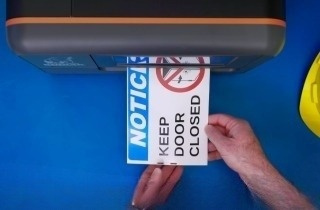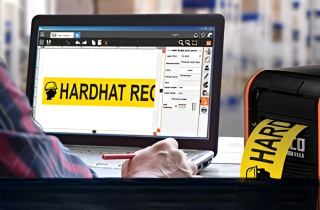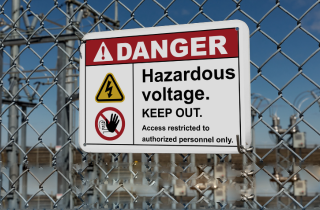How to Improve Fire Safety with Custom Labels and Signs

Why Does Fire Safety Signage Matter in Every Workplace?
Worksites that handle heat, fuel, and high-energy tools face more than visible hazards. A spark from a torch or grinder can land where it shouldn’t, and within seconds, smoke and confusion replace control. Even skilled crews can lose their bearings when alarms sound and visibility drops. Without clear visual cues, the fastest way out or the nearest extinguisher can vanish in the haze.
Fire safety signage restores order in those critical moments. Custom signs and labels make escape routes, extinguishers, and alarms impossible to miss, guiding workers toward action rather than panic. Beyond emergencies, consistent labeling builds daily awareness and supports compliance with Occupational Safety and Health Administration (OSHA) and National Fire Protection Association (NFPA) requirements for fire protection and emergency readiness.
Identifying Fire Hazards with Custom Labels
Fires rarely start from dramatic mistakes; they often begin with overlooked details. A stray spark, an unlabeled drum, or a tool stored too close to a heat source can ignite more than material; it can ignite chaos. In high-activity environments where sparks and heat are part of the job, prevention depends on constant visibility. Recognizing these risks early requires clear, durable labeling that communicates faster than words.
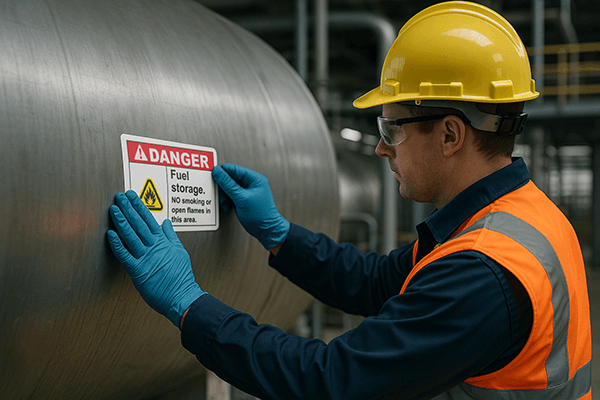
Custom fire safety labels mark ignition points, combustible materials, and high-heat zones where precision matters most. A label that reads “Keep Clear: Electrical Panel” or “No Open Flames: Fuel Storage” delivers clarity and relevance for each workspace. The more specific the message, the faster workers connect behavior to consequence.
Compliance standards such as OSHA 1910.1200 and NFPA 704 outline how hazard labels should include hazard pictograms, signal words, and color codes that align with recognized systems.
A red diamond, for instance, communicates flammability faster than words ever could. When used consistently, these visuals turn compliance into habit and awareness into everyday practice.
Strong labeling also promotes accountability. When hazards are clearly marked, responsibility becomes shared. Workers notice problems sooner, report them faster, and act with a clearer sense of consequence. That’s how prevention moves from policy to practice.
How Do Fire Equipment Signs Support Fast Emergency Response?
In a fire, time collapses. Thick smoke, low light, and alarm noise can disorient even seasoned workers. Fire equipment signs counter that confusion with clear, consistent visibility.
Effective fire equipment signage uses materials and design features such as:
- High-contrast, reflective finishes for visibility in smoke or low light
- Photoluminescent materials that glow during power outages
- Directional arrows and floor markers to guide workers quickly to exits and extinguishers
Strategic placement also matters. Equipment signage should be visible from multiple angles and installed above obstructions. Redundant visuals, such as wall signs, floor tape, overhead markings, reinforce familiarity, so employees move instinctively.
Together, these visuals transform a panicked environment into one that still communicates. When people can see where to go and what to use, they act faster and safer.
Fire Safety Labels for Compliance and Communication
Compliance and safety should overlap, not compete. Fire safety labels serve as a visible record of both. They display the information OSHA inspectors expect to see while serving as daily reminders for staff.
NFPA 10 requires fire extinguishers to be accessible, properly mounted, and identified by signage. OSHA’s 1910.157 standard echoes that expectation, stating that extinguishers must be “clearly located and identified.” Beyond extinguishers, labeling valves, alarm panels, and sprinkler control rooms ensures responders can act without delay.
Custom labeling options also help unify communication across facilities. When every site uses the same icons, colors, and messages, employees recognize what to do without second-guessing. Consistency builds confidence, and confidence builds safety.
Building a Visual Fire Safety System
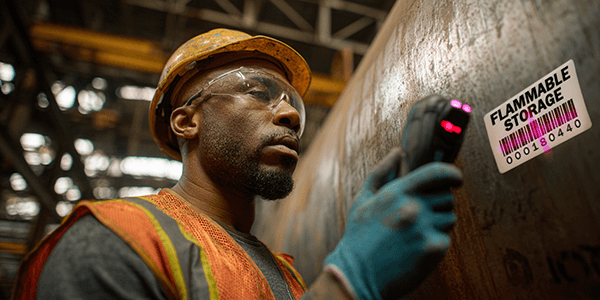
Signs and labels work best when they function as part of a larger system. Together, they form a language of visual communication that must be consistent and understood across the entire facility. A strong fire safety system blends prevention, compliance, and response through thoughtful design and placement.
Start with a layout audit. Identify high-risk areas, check for obstructed signage, and confirm that every fire-related device is marked from multiple viewing angles. Then, establish a standard: what size, shape, and color each sign should be, where it should go, and how often it’s inspected.
Once visibility gaps are clear, standardize. Decide which colors, materials, and label types represent fire safety throughout the facility. Integrate those visuals into existing organizational systems: mark red zones around extinguishers, define storage boundaries, and align labeling with 5S or Lean practices. When visuals and workflow connect, safety becomes a habit.
What Steps Strengthen a Fire Safety Signage Program?
Even the best signage fades or shifts over time. Heat, humidity, and wear can blur text or peel labels, creating false confidence. A proactive maintenance program keeps visuals reliable and compliant.
Here’s how to maintain effective signage:
- Inspect regularly: Check for fading, peeling, or damage. Replace signs immediately if text or color is no longer visible.
- Standardize materials: Use durable, temperature-resistant labels and signs rated for industrial use. Paper or thin vinyl decals may fail under heat or moisture.
- Train the team: Include signage awareness in fire drills and new-hire orientations. Workers should know what each symbol and color means.
- Document updates: Keep records of signage locations, materials, and replacement dates to maintain compliance during audits.
- Reassess after changes: When equipment or layouts shift, review signage placement to avoid hidden or conflicting messages.
Fire safety communication is only effective when it’s current. Regular checks ensure that when emergencies arise, signs perform as reliably as the people who rely on them.
DuraLabel Fire Safety Label Resources
Fire safety depends on clear, consistent communication that tells workers what to do when seconds matter. Standard safety signs can fade, peel, or fail under pressure. Custom labeling ensures every message, whether it’s a fire extinguisher location, emergency exit, or hazard warning, remains visible, legible, and compliant.
DuraLabel provides durable, industrial-grade labeling and signage solutions engineered to perform in high-heat, high-traffic environments. From NFPA-compliant fire extinguisher labels to on-demand custom evacuation signage, our solutions help facilities strengthen fire safety communication and meet OSHA and NFPA requirements with confidence.
Ready to build a stronger fire safety program? Download DuraLabel’s free OSHA Signage Quick Start Guide for step-by-step guidance on selecting the right headers, applying ANSI color and symbol standards, and choosing materials that withstand heat, humidity, and heavy wear.
Have questions? Call 1-888-789-7964 to connect with a DuraLabel safety specialist and start improving workplace fire safety with clear, lasting signage.
Read Next:
Labeling for Utility Emergencies During National Preparedness Month
Floor Marking That Improve Fire Safety and Compliance
Related Resources
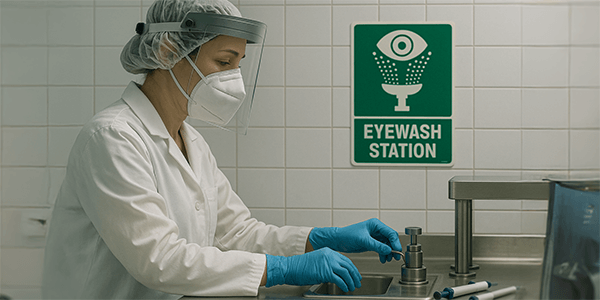
How to Improve Eyewash Station Safety in Healthcare Workspaces
How to Improve Eyewash Station Safety in Clinical and Lab Settings Our eyes are vulnerable in high-risk ...
Read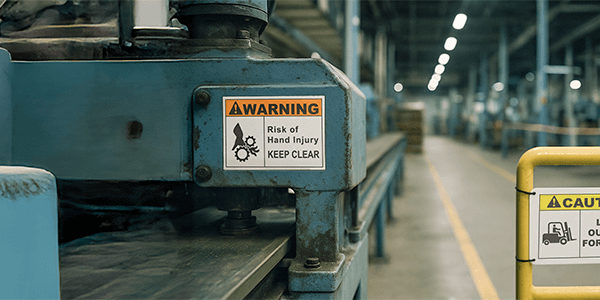
How Custom Signs Support OSHA Rules and ANSI Signage Requirements
Why Do Facilities Need Custom Signs to Meet OSHA Rules and ANSI Signage Requirements? Custom signage plays a ...
Read
4 Signs Your Safety Communication Needs an Update
Safety signs and labels that are up to date, clearly worded, and in tact play a key role in achieving ...
Read.png)

